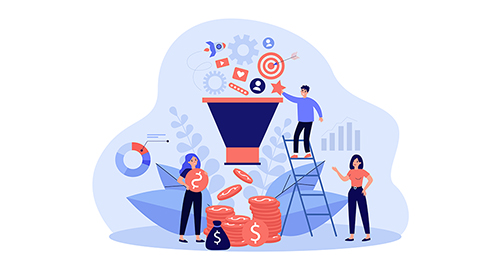7 Common Reasons Why Visitors Leave Your Website
You know the value of your website. Hence, you spend endless time and effort to beef it up to drive traffic to it. However, getting people to visit your website is one matter, but getting them to stay and explore more to increase the chances of conversions is another. It is difficult to convince visitors that your website is worth their time in this advanced digital age, where competition is tight, and information is not scarce.
Exit rate and bounce rate help measure visitors leaving your website. While exit rate refers to the percentage of people who left the last page in the session, bounce rate is the percentage of people who left your website after a single-page session. A high exit rate helps inform you of those pages with problem areas. A high bounce rate means you have a low number of engaged users which is a tell-tale sign of the quality of your page or the incoming traffic to your site. All website owners do not want their visitors to leave. Knowing the possible reasons why visitors leave your website is the best way forward.
1. Loading Speed Problem (Too Slow)

Ensuring your website performs in top condition can lead to higher visitor retention numbers (Source: PageSpeed Insights)
Studies have shown that users expect websites to load within 2 seconds. People like to be in control which is understandable because they know what to expect. So, if your website loads speedily, your audience believes that your website is responding to their actions which gives them a sense of control. However, if your website takes a long time to load, your visitors will no longer feel in control. Hence, their minds wander, they lose patience and leave. After all, many other similar websites are available (your competitors). They perceive your slow website as not functioning. Hence, you have catapulted your visitors to your competitor’s websites.
There are tools available in the market to check your website speed, such as PageSpeed Insights, WebPageTest, Pingdom Speed Test, Bitcatcha Website Speed Checker, etc. Also, Google takes speed as a ranking signal. You gain greater visibility by ranking high on the search results, and people’s perception of your relevance increases.
What You Can Do
You can look into the images/videos on your website. Ensure there are no overly-sized images or too huge videos, as these will cause your website to be sluggish. Use optimally-sized images and videos. You also must optimize your codes for better loading speeds and implement caching. Don’t forget to look into your web hosting solution; your website may have outgrown the capabilities of your current hosting plan.
2. Bombarding Ads on Your Visitors
While ads are the popular way to monetize your website, they are not the main reason your visitors arrive at your website. Put yourself in your visitor’s shoes. If ads are what you see the first thing you land on a website, won’t you feel annoyed? The first impression you’ll have of the business is that the company is only interested in making money and has no sincerity to help. Hence, these ads are seen more as a nuisance than anything useful. Also, if you place your ads everywhere on your website and each click produces pop-up ads, you can expect your visitors to leave.
What You Can Do
You cannot remove your ads which is understandable, but you can place them smartly. Do not irritate your audience. Hence, try your best to limit the number of ads. Then place them in such a way that they must not occupy more of your website’s space than the relevant content.
3. Unattractive Design and Layout
People judge the book by its cover; it is sad but true. Your bounce rate increases if your website sports an unappealing design with a bad image. Also, many tie a website’s design to its perceived trustworthiness. Design truly matters with the website’s layout too. Your audience’s time is limited; they won’t read all your content in detail. Instead, your audience scans your content. And if your website is cluttered and there is no seamless flow, your visitors will fail to grab the key points of your business. As such, they will give up and look elsewhere.
What You Can Do
Utilize an optimized approach when designing your website via a simple and clean website template. Use the correct font size and style, synchronized with a suitable color palette. Visuals and graphics need to appeal and relate to your business. Remember, your goal is to capture the audience’s attention and appeal to their hearts.
All website pages must have a clear and systematic layout to be easily digestible. Menu items need to be self-explanatory and content not haphazardly placed. Taglines/headers must display the business intent correctly. You may have to redesign your website, but the results will justify your effort.
4. The Navigation Issue
Have you come across a website where you go through an endless maze of button clicks to reach your destination? Well, I have, and the user experience is bitter. I instantly left for elsewhere. Remember, it does not take many clicks to lose your precious audience. A beautifully designed website is one thing, but a website that makes for easy navigation is another.
Patience is a virtue. Unfortunately, many cannot afford the luxury of time to check things through. Hence, if your website is mind-boggling to navigate, you can bet your bottom dollar your visitors won’t persist and will leave.
What You Can Do
Firstly, you have to know your targeted audience’s needs. Then ensure the related content is easily within reach. Never make them drill down to several sub-menus to find what they want. Otherwise, you’ll only frustrate them to leave. Have a clear and easy-to-understand hierarchical structure with visible easy-to-use menus in proper categorizations.
Take the approach to your website like it’s your first time. Then organize your website so that everything is easily at your fingertips. Simply put, your website must make for well-laid-out navigation options.
5. Security Is an Issue
People are becoming more security-conscious by the day. Thanks to the relentless hackers who scour the internet for vulnerabilities to exploit. People leave a website because they don’t see the security essentials in place. For example, if your website does not start with an ‘HTTPS,’ don’t expect your visitors to stay because they know their browser communication is not encrypted.
Security concerns are real. They can frighten your audience away. Forget collecting their personal information because they will never sign up for anything. Hence, beef up your website’s security. Presenting a secure website to your audience is a surefire way to assure them that you mean business and your business is trustworthy.
What You Can Do
Every website must have an SSL certificate; your website will have a padlock icon with the ‘HTTPS‘. The communications are encrypted and safe from prying eyes. Your audience will be more assured to stay on your website. Several web hosts include a free SSL certificate in their offerings from Let’s Encrypt. However, you can explore other certificate providers such as Thawte, GlobalSign, or DigiCert.
Also, consider displaying authorized trust symbols. These security badges are great to convince your audience to stay and make the purchase. Consider running security monitoring programs to keep everything about your website in check. You’ll be alerted for anything untoward to take the necessary action to prevent a disaster. Remember, prevention is better than cure.
6. Boring, Irrelevant, or Inaccurate Content
When I land on a website, I skim the keywords to grasp what is on offer. The same applies to many. Time is of the essence, so people don’t read down to the details. If they like what they gather, they will explore further. However, if they cannot understand or find what they want, it is only natural they will leave. Blogging is for your audience to keep updated with the relevant information. However, if your content is outdated and inaccurate, not only will the interest level in your content suffer, but also your authority status in your niche.
What You Can Do
Use the right keywords to reach out to your audience. You have around two seconds to snare your audience’s attention. Hence, don’t beat around the bush and go straight to the point. Have your headers categorized and organized well. Keep a schedule to update your content regularly. Your content must be fresh so that your readers look forward to returning.
Ensure your content is relevant and accurate. Inaccurate information means you’re being deceitful; not a good way to start a business. For example, if you’re doing a session in your blog on SSL’s history and impact, ensure that your facts are doubly checked and spot-on. The goal is to build a relationship with your visitors and prove your credibility. Also, pay attention to the typography used; this determines if your website becomes relatable and readable.
7. Your Website Is not Responsive

Mobile retail commerce sales share worldwide 2016-2021 (Source: Statista)
The number of mobile users worldwide today surpasses six billion. It is no wonder that most access the internet via their mobile devices. The mobile retail commerce sales share, a percentage of total retail e-commerce sales worldwide, is 72.9% in 2021. If your website does not support mobile devices, you’d only be doing a huge disservice.
When people cannot view your website on their smartphones or tablets, they will not think twice and leave. Google considers responsive websites a ranking factor. Hence, your website must be adaptive to support mobile devices if you want to rank high and stop your visitors from leaving.
What You Can Do
Check if your website is responsive against Google’s Mobile-Friendly Test or BrowserStack. Suppose you pass the test; congratulations. If not, get your act together and do something about this. Some invest in creating a whole new version optimized for mobile access. However, this isn’t very practical. Look into implementing a responsive design (more practical) that ensures that your website displays differently and accordingly, depending on the screen size.
Why Visitors Leave Your Website – Wrapping Up
Every website owner wants to reduce bounce and exit rates to ensure visitors do not leave your website. However, many often approach their websites from only their point of view, which is a flaw in itself. Remember, it is all about your website’s audience. They are the ones who determine the success of your business, so cater to them. The first step for your visitors to stay and not leave your website is to check if any of the above apply to you. Then make the necessary rectifications to help encourage them to stay.




Leave a Reply